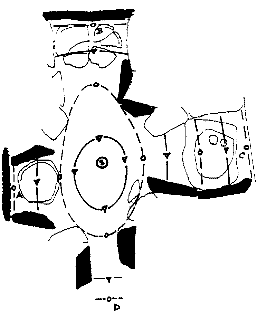 |
Science Frontiers ONLINE No. 102: Nov-Dec 1995 |
|
|
Ancient acoustical engineering
In SF#86/43*, we reviewed R. Waller's acoustical measurements at ancient rock-art sites in Europe, North America, and Australia. Waller claimed that some rock art was intentionally placed where echos from the walls are not only exceptionally loud but are also qualitatively related to the art's subject matter, such as running hoofed animals.
 The Newgrange chamber, with acoustical nodes and antinodes. Antinode occur at the chamber's stone walls. |
"Rudimentary acoustical measurements performed inside six diverse Neolithic and Iron Age structures revealed that each sustained a strong resonance at a frequency between 95 and 120 Hz (wavelength about 3m). Despite major differences in chamber shapes and sizes, the resonant modal patterns all featured strong antinodes at the outer walls, with appropriately configured nodes and antinodes interspersed toward the central source. In some cases, internal and exterior rock drawings resembled these acoustical patterns. Since the resonant frequencies are well within the adult male voice range, one may speculate that some forms of human chanting, enhanced by the cavity resonance, were invoked for ritual purpose."
In a few cases, it appeared that some of the standing stones had beeen intentionally positioned to enhance the chamber's acoustical properties. (Jahn, Robert G., et al; "Acoustical Resonances of Assorted Ancient Structures," Technical Report PEAR 95002, Princeton University, March 1995. Devereux, Paul, et al; "Acoustical Properties of Ancient Ceremonial Sites," Journal of Scientific Exploration, 9:438, 1995.)
Comment. Apparently, humans living over 5,000 years ago were rather sophisticated in their ability to manipulate sound to impress audiences. This talent has not been lost; for example, rock music!
*We will cross-reference SF items with both issue number (#00) and page number (/00) in the book Science Frontiers, which collects the first 86 issues of SF. For orders of the latter, see: here.